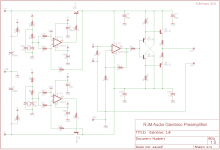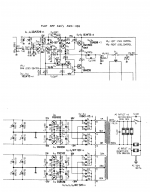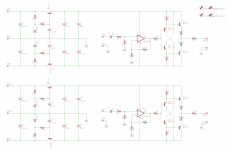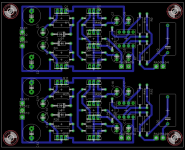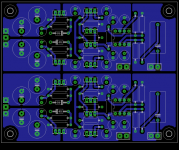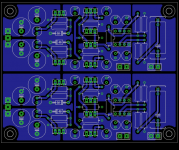New project, old ideas.
It's not that hard to design a low gain, buffer amplifier for line level signals. You don't have to worry about supplying gobs of output current, and neither are noise levels a big issue ... compared to high gain circuits.
12 dB of gain, decent output drive, and some "niceties" on the control front are all it would take.
My recipe: Take an Xreg smoother, a non-inverting OPA134 op amp or the like, and a discrete build of the LH0002 buffer with carefully matched BD135 and BD136 transistors pulling about 25 mA / 0.5 W each.
No coupling capacitors, and perhaps more controversially, the buffer will stay outside the op amp feedback loop.
Will drive headphones amplifiers without any trouble.
More to follow.
It's not that hard to design a low gain, buffer amplifier for line level signals. You don't have to worry about supplying gobs of output current, and neither are noise levels a big issue ... compared to high gain circuits.
12 dB of gain, decent output drive, and some "niceties" on the control front are all it would take.
My recipe: Take an Xreg smoother, a non-inverting OPA134 op amp or the like, and a discrete build of the LH0002 buffer with carefully matched BD135 and BD136 transistors pulling about 25 mA / 0.5 W each.
No coupling capacitors, and perhaps more controversially, the buffer will stay outside the op amp feedback loop.
Will drive headphones amplifiers without any trouble.
More to follow.
Extract from the schematic of the Pioneer C21 preamplifier showing one channel of the line stage and dual power supply which evolved from separate secondaries for each channel.
This was considered a high end unit at the time.
7 transistors for the amplification, and the old zener+transistor voltage regulator...
Food for thought.
(munch munch munch...)
This was considered a high end unit at the time.
7 transistors for the amplification, and the old zener+transistor voltage regulator...
Food for thought.
(munch munch munch...)
Attachments
The Xreg is a "voltage smoother" rather than a true voltage regulator as it lacks the DC reference voltage. If you remove both the error amplifier and the DC reference voltage, the circuit reduces to a classic capacitance multiplier.
Capacitance multipliers have a lot going for them, as elaborated here from Rod Elliott's original.
Capacitance multipliers have a lot going for them, as elaborated here from Rod Elliott's original.
Last edited:
Q. What's the difference between the Bryston bp4 preamplfier and a Chu Moy headphone amplifier?
A. Nothing. Both circuits comprise a single non-inverting op amp gain stage configured for 11x gain using 1k and 10k resistors. The Bryston bolts on diff. amps on the XLR inputs and an inverter for the negative XLR output signal, but for the single-ended signal path it's exactly the same circuit.
Driving headphones of course requires more output current than driving the input of a power amplifier, but the voltages are similar and for solid state circuits at least the difference in output current can safely be ignored.
So here's the first revision to pass DRC. It's a preamp - it's a headphone amp - it's whatever you need it to be. Two circuits on a 8x10 cm board.
The strong 70's vibe of this design is intentional. Retro solid state, with a tip of the hat to the Pioneer C-21.
A. Nothing. Both circuits comprise a single non-inverting op amp gain stage configured for 11x gain using 1k and 10k resistors. The Bryston bolts on diff. amps on the XLR inputs and an inverter for the negative XLR output signal, but for the single-ended signal path it's exactly the same circuit.
Driving headphones of course requires more output current than driving the input of a power amplifier, but the voltages are similar and for solid state circuits at least the difference in output current can safely be ignored.
So here's the first revision to pass DRC. It's a preamp - it's a headphone amp - it's whatever you need it to be. Two circuits on a 8x10 cm board.
The strong 70's vibe of this design is intentional. Retro solid state, with a tip of the hat to the Pioneer C-21.
Attachments
Last edited:
I move at a snails pace. No, worse than that!
I'd completely forgotten that I'd originally conceived of this as a preamplifier rather than a headphone amplifier.
This topic has been continued on a new thread
The circuit is endlessly configurable depending on the output load and power and desired balance of class A and class AB operation, and although I've been thinking of it mostly as a headphone amplifier lately it does make a rather neat little preamp at reduced bias currents.
I'd completely forgotten that I'd originally conceived of this as a preamplifier rather than a headphone amplifier.
This topic has been continued on a new thread
The circuit is endlessly configurable depending on the output load and power and desired balance of class A and class AB operation, and although I've been thinking of it mostly as a headphone amplifier lately it does make a rather neat little preamp at reduced bias currents.
And now it's a fully built prototype headphone amplifier, with "production ready" revision boards on order and a kit available momentarily. The relevant thread is
here.
I was asked in an email recently whether the Sapphire would make a good preamp. My response was an enthusiastic "yes!". The bias currents could be reduced somewhat, and the input section updated to include selectors switches, mono-stereo, mute, and balance controls, and could even add a phono stage like the VSPS300 or Phonoclone3. The output characteristics of the Sapphire are well-suited to be a line driver.
here.
I was asked in an email recently whether the Sapphire would make a good preamp. My response was an enthusiastic "yes!". The bias currents could be reduced somewhat, and the input section updated to include selectors switches, mono-stereo, mute, and balance controls, and could even add a phono stage like the VSPS300 or Phonoclone3. The output characteristics of the Sapphire are well-suited to be a line driver.
Last edited:
- Status
- This old topic is closed. If you want to reopen this topic, contact a moderator using the "Report Post" button.
- Home
- Source & Line
- Analog Line Level
- RJM Audio Gainbloc Preamplifier Mk. I
